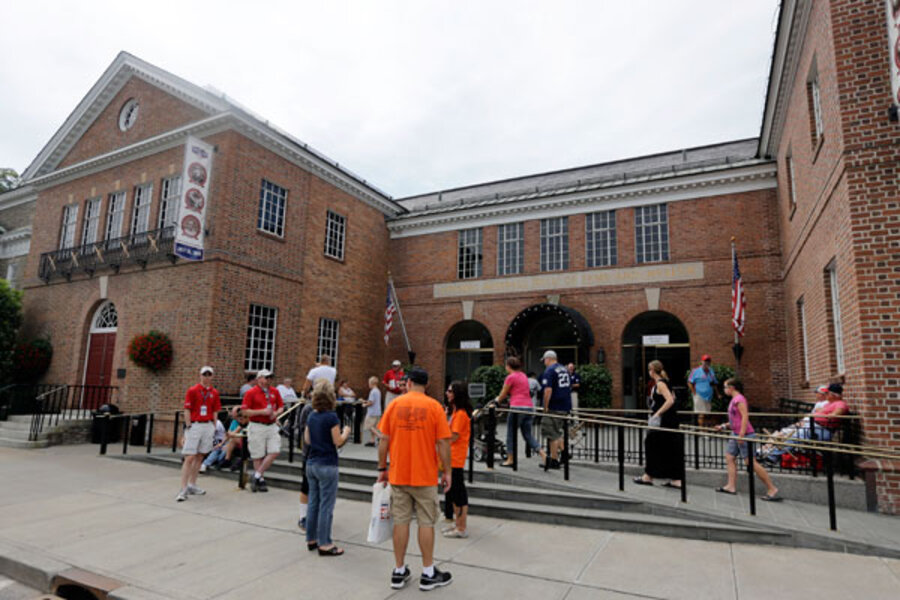Obama visits Cooperstown. Which president knew baseball best?
Loading...
| Washington
Today, President Obama is visiting the National Baseball Hall of Fame in Cooperstown, N.Y. He’s the first sitting US chief executive to drop in at this iconic site of Americana, apparently. At least one previous president visited Cooperstown but didn’t bother to go see Babe Ruth’s bat, Ty Cobb’s spikes, and so on. That may have been because that was so long ago the Hall of Fame didn’t yet exist.
“In fact, the last sitting president was Martin Van Buren in 1839 came to Cooperstown and I think that’s it,” Cooperstown Mayor Jeff Katz told the local cable news channel.
That’s surprising – some enterprising White House advance staffer should have pushed for such a visit long ago. The presidency and baseball fit together as easily as references to apple pie slip into advertising clichés. Throughout the game’s history, presidents have enjoyed it while basking in its implicit patriotism. They throw out first pitches, congratulate champions, and are filled with despair when the Detroit Tigers blow three late-inning leads against the Cleveland Indians and lose 11-10 in 13 innings.
OK, we made that last one up but the game yesterday was a killer. The Indians! Bring back Jim Leyland.
Recent presidential connections to baseball are pretty well-known. George W. Bush is the only former team owner to win the White House – he used to be a partner in the Texas Rangers, remember. His dad, George H. W. Bush, was one of the best players to become president, serving as a slick-fielding but light-hitting first baseman on the Yale team. Dwight Eisenhower used to say that perhaps the greatest disappointment of his life was failing to make the West Point baseball team.
But which president actually knew the most about baseball? The answer to that, as to so many questions about the modern presidency, is the confounding, enigmatic, profane, far-sighted, possibly felonious Richard Nixon.
Nixon went to 11 major league games during his time in office. “I love the game, love the competition,” he said. He was the first president to bother to travel outside of Washington to throw out a seasonal first pitch. He was the first – and as far as we can determine, the only – president to see a triple play.
He’s also the only president to draw up his own all-star teams. At the end of a June 22, 1972 press conference, a radio reporter asked him who his favorite players were, and whether he’d be willing to draw up his all-time baseball team. Nixon said “yes” and threw himself into the task.
Of course, Nixon threw himself into every task. Otherwise he’d have been a small-town lawyer in Whittier, Calif. Maybe he needed a distraction. The Watergate break-in had occurred on June 17 and was starting to percolate into news coverage. So that weekend Nixon dragged his son-in-law David Eisenhower out to Camp David and they started making lists.
“The P is all cranked up about his baseball all-time-great story,” wrote Nixon’s Chief of Staff H. R. Haldeman in his diary entry of June 26.
Nixon split baseball into two eras, using 1945 as a dividing line, and picked a National and American League team for each era. So he named four teams in all. Press Secretary Ron Ziegler distributed the choices in a press release on June 30.
Sportswriters generally thought his choices sound. Some questioned his choice of Satchel Paige for the pre-1945 AL squad, since Paige was kept out of major league ball at that time due to racial discrimination. New York Times sportswriter Red Smith opined that Nixon’s all-star piece was poorly written and “cliché-ridden”.
Per above, we’d say clichés and baseball go together like apple pie and frilled aprons. Undemanding emotional resonance is sort of the point of much baseball fandom.
Nixon won reelection in a landslide that fall. In 1992, as a disgraced ex-president forced from office, he drew up a series of updated teams, which again were generally reflective of the consensus of the time. Although they did not contain enough Detroit Tigers.






